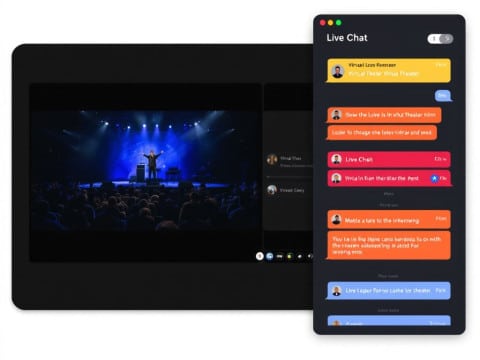Isn’t it the worst when you get that dreaded call… a media interview coming up? Panic sets in and it’s like, where do you even start? But, hold on—let’s not freak out just yet about facing the glare of those intimidating cameras. Prepping for that spotlight moment is a skill in itself. So let’s dive into mastering the fine art of having camera-ready skin for media interviews. This is all about making you look your best self, naturally.
Understanding the Importance of Media Interview Skin
Imagine yourself under those bright studio lights where every little detail of your face is amplified. Terrifying? Maybe a little. But here’s the deal: cameras tend to exaggerate imperfections while highlighting dry patches or overly shiny areas. This is why “media interview skin” isn’t just a vanity move—it’s essential event preparation. Trust me, nailing this means you’ll look and feel more confident stepping in front of the camera.
The aim here is simple: achieving a polished, hydrated, and natural look without appearing overly done up. It’s about striking that perfect balance where you’re glowing, but not blinding.
Step-by-Step Guide to Achieving Flawless Media Interview Skin
Getting camera-ready doesn’t need an assault of complex, hard-to-follow routines. Let’s break it down into simple, actionable steps that you can easily replicate.
Step 1: Skin Care – The Base of Your Canvas
Your skin is your canvas (yes, really!), so it’s crucial to take care of it before you even think about makeup. First things first, clean skin is a must. This keeps any dirt or, yikes, yesterday’s product from creeping into today’s look. Gentle cleanser with AHA or BHA? That’s your starting line.
Okay, I know “exfoliation” often gets thrown around, but it’s vital. Exfoliating twice a week keeps your skin smooth and helps makeup sit better. Think of it as setting up a good foundation—even before the actual foundation.

Finally, don’t skimp on moisturizing. Yes, that means even if you’ve got oily skin. Hydrated skin is the key to natural glow. Apply a lightweight moisturizer before you even consider putting on any primer. Trust me on this one—not having crusty spots on camera is totally worth it.
Step 2: Priming – Setting the Stage
Ever used a primer before? If not, now’s the time to start. Primers smooth out your skin’s texture, making sure any makeup you apply doesn’t settle into fine lines or uneven areas. Think of it as spackle for your face, filling in holes so the finished look is flawless.
Choose what feels right for your skin type—a mattifying primer if shine is your enemy, or a luminous primer for dry type. A pea-sized amount will do; don’t overdo it. Just enough to ensure your makeup stays put throughout the interview.
Step 3: Foundation – Finding the Perfect Match
Here’s where it gets interesting—foundation. It’s crucial you choose a shade that matches your skin tone perfectly. Bad lighting can really bring out any mismatched base tones, and that’s definitely not the star impression you’re trying to make. Test a few shades on your jawline to see which one vanishes into your skin.
When applying, start from the center of your face and work outwards in light, sweeping motions. A beauty blender or brush does the job fine, whatever you’re comfortable with. Think thin veneer here; the aim is to even out your skin tone without looking like a kabuki painting.
Step 4: Concealer – For Finesse
No one’s skin is completely flawless, and that’s okay. This is where concealer becomes your friend, not foe. It’s about spot-targeting imperfections and those stubborn dark under-eye circles. Use a concealer that’s a shade lighter for under the eyes, dab it on gently, and blend without rubbing too much.
Apply it sparingly—that’s key. The point is to subtly illuminate those trouble spots, not cake on for the sake of covering every flaw.

Step 5: Setting Powder – Lock it In
To prevent shine while keeping everything on lockdown, dust on some translucent setting powder. Trust me, in this case, less is more. You don’t want to look powdery; a light sweep will a do wonders. Focus on areas prone to oiliness like your T-zone.
Step 6: Blush and Bronzer – Add Dimension
A little color brings your face back to life under harsh camera lights. Sweep a bit of blush on the apples of your cheeks (nothing too clownish!) and use bronzer for a hint of contour to define your features subtly. This helps your face maintain its natural contours and adds depth that lighting might wash out.
Quick Fixes for That Emergency Sit Down
Even with perfect preparation, we all know skin sometimes decides to rebel. Got a spot on the big day? Dabble a tiny bit of salicylic acid on your pimple, wait for it to dry, then lightly layer on concealer.
And if your face feels greasy from nerves rushing the oil glands? Blotting papers will be your interview knight. A quick blot and you’re set again.
Staying Toxic-Free: The Skincare-Makeup Balance
Having healthy media interview skin is a marriage between skincare and makeup. Your skin needs care, not just layers of product. Look for labels with ingredients that nourish, hydrate, and protect—think hyaluronic acid, niacinamide, and peptides. Your products should work with the skin, not against it. When in doubt, reach for options that promise more skin-loving benefits.
Hydration is Key

Don’t underestimate the home run of good skincare: drink plenty of water. Yes, we’ve heard this, just like always remembering your grandma’s advice—it remains evergreen. Hydrated skin radiates naturally, needing less makeup to achieve that coveted glow.
Finishing Touches
Sweep on some setting spray to simmer everything into place; it’ll help your face hold together under the heat of the interview lights. A spritz acts like a gentle mist, sealing your hard work in place.
Handling Post-Interview Skin Recovery
You’ve nailed it; the interview’s over. Now, let’s pamper that hardworking skin of yours. Remove all makeup gear with a smooth, gentle cleanser. Follow up with a hydrating sheet mask to replenish—and snack on your chocolate for emotional recovery (just kidding).
Manage Stress, Nurture Skin
Stress equals skin problems, thanks to cortisol sky-rocketing fairness. Do yourself a solid favor: maintain calmness before and after the interview. A few yoga stretches, some mind-calming exercises, or a journey into breathing techniques to lower the tension occasionally won’t hurt.
Wrapping Up This Media Marvel
Hitting the airwaves prepared for any media event means you’ll communicate with authenticity and command. When you’re speaking confidently, joined by your radiant on-camera presence, the whole message translates stronger.
And remember, confidence is your ultimate accessory. These steps for achieving impeccable media interview skin transform you into an articulate vision, marrying clarity of attire with serene skin coverage. With this guide, be set to own each encounter. Now, go present yourself and charm the broadcasters right off their feet. You’re primed and polished for media greatness!
Frequently Asked Questions
What are the key elements to consider when planning an event?
When planning an event, it is crucial to consider several key elements. These include defining the type of event and its goals, determining the guest list and expected attendance, thinking about the physical space and its usage, and ensuring all necessary registrations and permits are obtained. Additionally, planning for catering, audio-video needs, and post-event cleanup is essential[1][3].
How do I ensure the logistical aspects of my event are well-managed?
Effective event management involves strategic planning, creative development, logistical planning, and execution. This includes managing the budget, scheduling, site selection, acquiring necessary permits, coordinating transportation and parking, arranging for speakers or entertainers, and ensuring compliance with health and safety standards. Using the 3 C’s of event management – Concept, Coordination, and Control – can help ensure the event is well-planned and executed[3].
What stages are involved in the event planning process?
The event planning process typically involves several stages: Research, Design, Planning, Coordination, Evaluation, Implementation, and Follow-up. These stages guide event planners from the initial concept to post-event analysis, ensuring a structured approach to creating successful and memorable events. Additionally, the 5 stages of event management – Initiation, Planning, Execution, Monitoring and controlling, and Closure – provide a comprehensive framework[3].
How can I promote my event effectively to attract attendees?
Promoting an event effectively involves several strategies. These include setting up a registration form and landing page, sending targeted email campaigns, using social media, paid advertising, and partner promotions to reach a wider audience. It is also important to send reminder emails to registered attendees and to design the event website and registration form to be user-friendly and consistent across multiple events[2][4].
References










